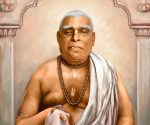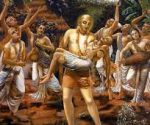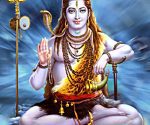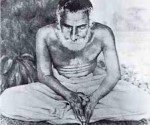Srila Jiva Gosvami’s Disappearance Day
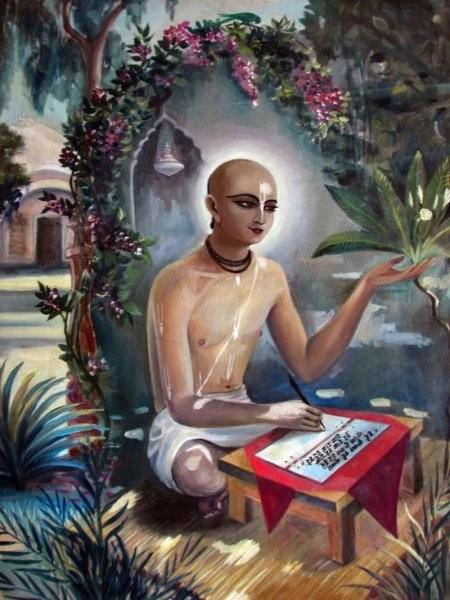 Sri Srimad Bhaktivedanta Narayana Gosvami Maharaja – Oahu, Hawaii: Jan. 16, 2002 (Evening – Part 1)
Sri Srimad Bhaktivedanta Narayana Gosvami Maharaja – Oahu, Hawaii: Jan. 16, 2002 (Evening – Part 1)
Today is a very auspicious day. It is the disappearance day of Srila Jiva Gosvami. We don’t observe the disappearance days of Lord Krsna, Lord Caitanya Mahaprabhu, Lord Rama or any other incarnation of the Supreme Lord, but we observe the disappearance days of His associates. By such observance we learn many things about these associates’ worshipful Sri Sri Radha-Krsna, Sriman Mahaprabhu and Sri Nityananda Prabhu.
We can understand how they practiced bhakti-yoga and how they received the service of Krsna and Mahaprabhu. We can learn from their lives’ examples how they accepted the process of sadhu-sanga (association of pure devotees), bhajana-kriya (the execution of devotional practices) and anartha-nivrtti (the clearing away of thoughts and habits which are unfavorable to bhakti).
We learn how their devotion gradually developed to nistha (strong faith), ruci (taste), asakti (spiritual attachment) and rati (spiritual sentiments). This is more important for us. [Although they are nitya-siddha (eternally perfect) devotees, they sometimes act as conditioned souls in the beginning, so that we can learn how a conditioned soul can become a pure devotee.]
Sri Caitanya Mahaprabhu, the original Supreme Personality of Godhead, Sri Krsna Himself, who has taken the beauty and intrinsic mood of Srimati Radhika, came to this world; but it was Srila Rupa Gosvami who established in this world His innermost heart’s feelings. If Srila Rupa Gosvami had not come, perhaps we would not have known His identity. Srila Jiva Gosvami served Srila Rupa Gosvami, and the credit for all the publishing of Srila Rupa Gosvami’s literatures belongs to him. By publishing Rupa Gosvami’s literatures, he established his innermost desire. At that time it was very difficult to publish books, because the authors had to write all their books with their own pens; there were no printing presses. Jiva Gosvami wrote down, in his own handwriting, every copy of every book of Srila Rupa Gosvami.
Srila Jiva Gosvami was the topmost learned person at that time, and he preserved the legacy of Srila Rupa Gosvami. Because he was always with him, he was able to write many commentaries in pursuance of Rupanuga Vaisnavism. If it were not for him, all of Srila Rupa Gosvami’s books would have been lost. He also preached, especially to Sri Syamananda Prabhu, Sri Narottama dasa Thakura, and Sri Srinivasa Acarya. Try to practice serving the cause of Caitanya Mahaprabhu’s mission as he has done.
So-called gurus hanker to make many disciples. They spend so much money, make so many agents, and tell them, “If you bring five disciples, I will pay you so much.” This is going on nowadays, but Srila Jiva Gosvami and the Six Gosvamis did not practice this.
How many disciples did Srila Raghunatha dasa Gosvami, Srila Sanatana Gosvami, Srila Rupa Gosvami and Srila Raghunatha Bhatta have? Srila Jiva Gosvami did not have any formal disciples at all, but the whole world is his disciple. Sri Syamananda Prabhu was initiated by another guru, Sri Hrdaya Caitanya, Srila Narottama dasa Thakura was initiated by Srila Lokanatha dasa Gosvami, and Srila Srinivasa Acarya was initiated by Srila Gopala Bhatta Gosvami. However, they all came under the shelter of Srila Jiva Gosvami. Srila Jiva Gosvami explained to them the Vedas, Upanisads, and all other sastras, and he also thoroughly explained to them all the established philosophical truths.
They wanted to be initiated by him, but he refused. He told them, “There are so many elevated Vaisnavas more qualified than I. Please, you should go to Lokanatha Gosvami, and you should go to Gopal Bhatta Gosvami.” They had not intended to go to them; they wanted Srila Jiva Gosvami to be their guru. Yet, they followed his instructions. Srila Narottama dasa Thakura went to Srila Lokanatha Gosvami Prabhu and Srila Srinivasa Acarya Prabhu went to Srila Gopala Bhatta Gosvami.
Lokanatha Gosvami refused to give Narottama dasa Thakura initiation, although the Thakura waited for many years. Finally, in the early morning, Narottama dasa cleaned the place where Lokanatha Gosvami had passed stool, and finally, seeing his sincerity of purpose, Lokanatha Gosvami was bound to give him initiation. Similarly, Gopal Bhatta Gosvami never wanted to accept any disciples, but by the request of Srila Jiva Gosvami he accepted one disciple – Srinivasa Acarya. However, those two disciples, along with Syamananda Prabhu, went to Bengal and collected thousands and thousands of followers.
Srila Gaura Kisora dasa Babaji also never wanted to accept any disciples. Only by the special request of Srila Bhaktivinoda Thakura did he initiate Bhaktivinoda Thakura’s son, Srila Prabhupada Bhaktisiddhanta Sarasvati Gosvami. He saw in his own heart that if he did not initiate Srila Sarasvati Thakura, Srila Sarasvati Thakura would die. Srila Babaji Maharaja was therefore bound to give him initiation, but he gave no initiation to anyone else.
His disciple, Srila Sarasvati Thakura, performed a miracle. He made disciples in all of Bengal, all over India, and after that all over the world. Thus, who is more merciful: the guru or the disciple? We see that disciples are more merciful than their gurus. This is because they go out to everyone, to invite them to experience the mercy of their guru.
Once, when Srila Lokanatha Gosvami and his disciple Srila Narottama dasa Thakura were both engaged in bhajana, a thirsty person came to them desiring water. He went to Lokanatha Gosvami, who was chanting and absorbed, oblivious to his presence. Then, when he went to Narottama dasa Thakura, the Thakura procured some water and gave it to him. Lokanatha Gosvami understood this and later told him, “You are not qualified. You should go at once to your village. I don’t want a disciple like you, who has no faith in Lord Sri Krsna’s name. Krsna’s name is Krsna Himself. He has manifested all His power, beauty and opulence in His name. His name is more powerful than He Himself, but you have no faith in this truth.”
Srila Lokanatha dasa Gosvami told Srila Narottama dasa that he was not qualified because he had interrupted his service to Radhika and Krsna, and went to serve an ordinary man. [Srila Narayana Maharaja explained on another day that in real bhajana, the devotee is personally serving Srimati Radha and Sri Krsna while chanting. Had Srila Narottama dasa Thakura continued his bhajana, Krsna would have been pleased and the man also would have been pleased. By Lord Krsna’s arrangement, he would have gotten water from another source.] Srila Narottama dasa Thakura was so faithful that he followed his guru’s instruction to leave Vrndavana, and he also initiated thousands and thousands of disciples in the course of his preaching on his guru’s behalf.
I think that Srila Narottama dasa Thakura is so much more merciful than his Gurudeva. Although Lokanatha Gosvami is a manjari and Narottama dasa Thakura is also a manjari, it appears that Narottama dasa Thakura is more merciful. He had mercy for all, as shown by his extensive preaching. In another way, however, we can see that Lokanatha Gosvami is extremely merciful, because he parted with his only disciple, who served him so intimately, just so the people of Bengal could benefit.
There are many teachings to contemplate in this regard. If Srila Jiva Gosvami had not written Sri Sad-Sandarbha, if he had not written Sri Gopala Campu, if he had not revealed his commentaries on Sri Ujjvala Nilamani, Sri Bhakti-rasamrita-sindu, and so many other books, we would not be able to know the mercy of Srila Rupa Gosvami. We therefore offer our obeisances today unto the lotus feet of Srila Jiva Gosvami. We pray that we may serve our Gurudeva as he served Srila Rupa Gosvami. He manifested both Sri Caitanya Mahaprabhu and Sri Sri Radha-Krsna. It is very rare for anyone to be like him.
Srila Jiva Gosvami
Perth, Australia: 1998
All jivas (spirit souls) have a special relationship with Sri Krsna. Some are related with Him in the mood of friendship. Others have a relationship in the mood that “Krsna is my son,” and that is called parental mood (vatsalya). Moreover, some have the mood that “Krsna is my beloved.” All jivas have their own original, eternal relationship with Krsna. In this material world, that eternal relationship is covered. Sri Guru can see the soul’s real form and nature. He knows the specialty of that person’s relationship with Krsna, and he bestows this special relationship by mantra.
Did Srila Jiva Gosvami do the right thing when he defeated the arguments of Sri Vallabhacarya and defended his Gurudeva?
[Devotees:] He was right.
[Srila Narayana Maharaja:] But what about his Gurudeva, Srila Rupa Gosvami? Was he right or wrong?
[Devotees:] He was right.
[Srila Narayana Maharaja:] How is that? If Srila Jiva Gosvami did the right thing, then Srila Rupa Gosvami must be wrong. How can Srila Rupa Gosvami be right?
[Devotee:] Because he is Guru, he has the qualification that he can correct…
[Srila Narayana Maharaja:] This is not a good argument.
[Devotee:] Srila Rupa Gosvami is Guru. He is:
trnad api sunicena
taror api sahisnuna
amanina manadena
kirtaniyah sada harih
[“One can chant the holy name of the Lord in a humble state of mind, thinking himself lower than the straw in the street. One should be more tolerant than the tree, devoid of all sense of false prestige and ready to offer all respects to others. In such a state of mind one can chant the holy name of the Lord constantly.” (Sri Siksastaka 3)]
Srila Rupa Gosvami wants to respect everyone without desiring respect for himself. But Srila Jiva Gosvami could not tolerate that his Gurudeva was criticized.
[Srila Narayana Maharaja:] This is not the answer. This logic is not correct.
[Devotee:] Srila Rupa Gosvami sent Jiva Gosvami away because he wanted to increase Jiva Gosvami’s love by making him feel separation.
[Srila Narayana Maharaja:] No. The answer is that Srila Rupa Gosvami wanted to respect Sri Vallabhacarya, but his disciple, Jiva Gosvami, disrespected him. This was wrong. Srila Rupa Gosvami considered, “Sri Vallabhacarya may think, ‘Rupa Gosvami is not openly disrespecting me, but he is disrespecting me through his disciple.’” Therefore, some blame might come to Rupa Gosvami. By punishing his disciple, Jiva Gosvami, Srila Rupa Gosvami was giving respect to Sri Vallabhacarya.
Actually, Srila Rupa Gosvami was right and Srila Jiva Gosvami was also right. A disciple should not tolerate anything against his Gurudeva. Thus, both the guru and disciple were right. Srila Rupa Gosvami wanted to respect Sri Vallabhacarya, and he did.
After Srila Rupa Gosvami told him to leave, where did Srila Jiva Gosvami go? He went to Nandagatha.
(Correcting a devotee who had been called on to speak in the class) Srila Jiva Gosvami’s designation is not that he is the son of Anupama. His designation is that he is the disciple of Srila Rupa Gosvami. Don’t say this. If you are explaining his life in great detail and you have a lot of time, then you can tell this; otherwise not. This is his glory – his glorification – and nothing else. He is the disciple of Srila Rupa Gosvami.
If we say, “Srila Prabhupada Bhaktisiddhanta Sarasvati Thakura is the son of Srila Bhaktivinoda Thakura,” this is not Srila Prabhupada’s glorification. His real glory is that he is the disciple of Srila Gaura Kisora dasa Babaji Maharaja and Srila Bhaktivinoda Thakura. Actually he is the disciple of Srila Bhaktivinoda Thakura, but in disciplic line we say that he is the disciple of Srila Gaura Kisora dasa Babaji Maharaja. Srila Bhaktivinoda Thakura was his bhagavad-parampara-guru, sravana-guru and bhajana-guru; and Srila Gaura Kisora dasa Babaji Maharaja was his mantra-guru, or diksa-guru.
Sometimes the bhagavad-parampara-guru, the bhajana-guru, is superior to the diksa-guru. If the diksa-guru is also the bhajana-guru, then he is also exalted.
Srila Jiva Gosvami is a brilliant star in our disciplic line. He is a brilliant and learned acarya – the greatest scholar – in the Brahma-Madhava Gaudiya Vaisnava Sampradaya. When Sri Caitanya Mahaprabhu was on his way to Vrndavana, he met with Srila Rupa Gosvami and Srila Sanatana Gosvami in Ramakeli, near Kamainatshala.
Jiva Gosvami was only a baby at that time. Rupa Gosvami and Sanatana Gosvami brought that baby and placed him at the lotus feet of Mahaprabhu, who then touched him with His lotus feet. Playing the role of an ordinary sadhaka, Srila Jiva Gosvami said in Navadvipa that he did not remember this so vividly. He said he only had a very vague remembrance of that time when he touched the lotus feet of Sri Caitanya Mahaprabhu.
Srila Rupa Gosvami later made arrangements for Srila Jiva Gosvami’s education. He gave money to Jiva Gosvami’s family so that they could help him with his studies. Thus, even in boyhood, Jiva Gosvami became a great scholar in Bengali, Sanskrit, Urdu, Arabic and Farsi. He was an unparalleled scholar of Sanskrit, especially of Sanskrit grammar.
When he was about ten years old, Srila Jiva Gosvami left his home and went to Navadvipa. At that time Sri Caitanya Mahaprabhu had already left this world. Srimati Saci-maiya, Srimati Visnupriya and Sri Nityananda Prabhu were present in Navadvipa at that time, and they were all weeping for Sri Caitanya Mahaprabhu. When Srila Jiva Gosvami arrived there, Srila Nityananda Prabhu put His feet on the head of Srila Jiva Gosvami and inspired in his heart all tattva (knowledge and realization). Jiva then began to cry for Sri Caitanya Mahaprabhu.
Sri Nityananda Prabhu said, “Come with me. I will take you on parikrama of the sixteen krosas (thirty-two square miles) of Sri Navadvipa Mandala.” He then took Jiva to the nine islands of Navadvipa: Antardvipa, Simantadvipa, Godrumadvipa, Madhyadvipa, Koladvipa, Rtudvipa, Jahnudvipa, Modadrumadvipa and Rudradvipa. He especially showed him Sri Yogapitha, the birthplace of Sri Caitanya Mahaprabhu, situated on the island called Mayapura.
Srila Jiva Gosvami told Nityananda Prabhu, “I want to stay here, at Your lotus feet.” But Nityananda p(P)rabhu said, “Sri Caitanya Mahaprabhu told Srila Rupa Gosvami, “I am giving you and your whole family to Vrndavana.” So you should also go to Vrndavana, to be with Srila Rupa Gosvami and Srila Sanatana Gosvami.
“On the way you should stop in Varanasi, and there you should study all the Vedanta-darsana (another name for Vedanta-sutra). You should learn the explanations of Sankara, Madhva, Visnusvami, Nimbaditya and Ramanujacarya, and then you should go to Vrndavana.”
Thus, Srila Jiva Gosvami went to Kasi (Varanasi), where he met the disciple of Sri Sarvabhauma Bhattacarya named Madhusudana Vidya-vacaspati. This disciple had studied Vedanta under the guidance of Sarvabhauma Bhattacarya. He had learned everything that Sarvabhauma Bhattacarya had received from Sri Caitanya Mahaprabhu, and he now taught that to Srila Jiva Gosvami.
After Srila Jiva Gosvami became expert in all these topics, he went to Vrndavana and took shelter at the lotus feet of Srila Rupa Gosvami and Srila Sanatana Gosvami. Srila Sanatana Gosvami told Srila Rupa Gosvami, “You should initiate him.” So Srila Rupa Gosvami initiated that boy.
Srila Rupa Gosvami then taught Srila Jiva Gosvami about everything he himself had written – Sri Bhakti-rasamrta-sindhu, Sri Ujjvala-nilamani, Sri Vidagdha-madhava, Sri Lalita-madhava and so on.
Srila Rupa Gosvami’s books are rasa-sastra (scriptures delineating topics regarding Sri Krsna and His beloved associates], and thus Srila Jiva Gosvami became a learned scholar in that as well. When Jiva Gosvami fully mastered all topics taught to him by his guru, Srila Rupa Gosvami engaged him in proofreading his books and checking his writings for grammatical mistakes.
One day Sri Vallabhacarya came to see Rupa Gosvami. They were well acquainted because when Sri Caitanya Mahaprabhu had met with Rupa and Anupama in Arhailgrama, their native place near Prayag, Vallabacarya was present. Very good discourses took place at that time.
Sri Vallabhacarya now inquired, “Are you writing any book?”
Srila Rupa Gosvami answered, “Oh yes, I am writing.”
Sri Vallabhacarya then asked, “Which book you are writing?”
“Sri Bhakti-rasamrta-sindhu,” Srila Rupa Gosvami replied.
“Oh, that is a very good book. May I see it?” Sri Vallabhacarya requested.
Srila Rupa Gosvami agreed and Sri Vallabhacarya took the book. Reading it, he saw this verse:
bhukti-mukti-sprha yavat pisaci hrdi vartate
tavad bhakti sukhasyatra katham abhyudayo bhavet
[“As long as the witches of bhukti and mukti linger in the heart, how can pure bhakti arise?” (Bhakti-rasamrta-sindhu, Purva 2.16)]
Vallabhacarya read Rupa Gosvami’s explanation: that mukti (liberation) is not like a witch. It is the desire to achieve mukti that is like a witch. Vallabhacarya did not understand this fact; so, Jiva although a youth of only sixteen years, explained it to him.
Vallabhacarya was impressed. He went back to Srila Rupa Gosvami and said, “Oh, your disciple is such a learned boy.” Srila Rupa Gosvami could understand Jiva had defended him, and he told him, “You should have been tolerant. Sri Vallabhacarya is a brahmana. He is learned and he is also Vaisnava. And he is visiting Me. He is my guest. You cannot tolerate that he suggests some corrections?
In this way, the behavior of Srila Rupa Gosvami is correct. On the other hand, it would not have been right for Srila Jiva Gosvami to tolerate the fact that Sri Vallabhacarya was attempting to correct his Gurudeva. He was right to defend his Gurudeva. Srila Rupa Gosvami is not an ordinary Vaisnava. He is the associate of Sri Sri Radha and Krsna in Goloka-Vrndavana. He cannot make any mistake. Srila Jiva Gosvami argued some points and defeated Sri Vallabhacarya, and this was the right thing to do.
If anyone thinks he can correct the writing or teachings of our Gurudeva, we must also act like this, but when we are in the position of Srila Rupa Gosvami, we should honor the other person and say, “You can correct me, no harm.” This is the behavior of a Vaisnava. Rupa Gosvami was not angry at Jiva Gosvami from his heart; he only showed some anger externally, and thus told him to leave.
When Sanatana Gosvami heard what had happened, he became very worried for Jiva Gosvami. When he arrived at that place, Nandagatha, all the villagers approached him and said, “Oh, a new baba has come here. He is very young, but he is always weeping and crying out in love for Krsna: “Oh, Krsna! Oh, Radhe, Radhe!” He weeps day and night. He is more qualified than you.”
Srila Sanatana Gosvami thought, “Oh, he must be Jiva!” In this way he found Jiva Gosvami and saw that he was about to die. Jiva Gosvami had given up eating and drinking, he did not take baths, and he was continually weeping for his Gurudeva.
Srila Sanatana Gosvami took him back to Vrndavana and hid him somewhere there. Then he went to Srila Rupa Gosvami and asked, “What is our duty to all jivas?” Srila Rupa Gosvami replied, “We should be very kind.” Srila Sanatana Gosvami then said, “Well, is this Jiva not a jiva? Why you are so unkind to this Jiva?”
Rupa Gosvami began to weep. Sanatana Gosvami called Jiva Gosvami and put him in Rupa Gosvami’s lap. Rupa Gosvami, seeing that Jiva Gosvami had so many diseases and was about to die, embraced him and nourished him. He gave Jiva Gosvami medicine, and after some days Jiva Gosvami became cured. After that, Jiva Gosvami always remained in the service of Srila Rupa Gosvami.
When Rupa Gosvami and Sanatana Gosvami left this world, Jiva Gosvami became the prominent acarya of the Visva Vaisnava Raja Sabha (World Vaisnava Association). This is the real Krsna consciousness movement, which was established by Lord Brahma himself. Sri Narada Muni, Srila Vyasadeva and Srila Sukadeva Gosvami are acaryas of the real Krsna consciousness movement, and later, Srila Jiva Gosvami became its prominent acarya.
I saw a book today, written by Srila Gour Govinda Maharaja. Therein, Srila Gour Govinda Maharaja made a point that I think no one in Iskcon after Parama-pujyapada Srila Swami Maharaja had ever written before. He clearly wrote that Srila Prabhupada Bhaktivedanta Swami Maharaja did not establish the Krsna consciousness movement. Who is the establisher? It is Lord Brahma* [See Endnote 1].
Moreover, Brahma is also not the establisher; he is also a disciple. Sri Krsna is the root of all gurus. He is jagad-guru (the guru of the entire universe), as is Sri Caitanya Mahaprabhu. The Krsna consciousness movement is coming from Krsna, and it is therefore called “Krsna consciousness”. Parama-pujyapada Srila Bhaktivedanta Swami Maharaja is not the establisher of Krsna consciousness; he is one of the prominent acaryas in this line.* [See Endnote 2] We should realize all these facts.
After Rupa Gosvami and Sanatana Gosvami disappeared, Jiva Gosvami spread the mission of Sri Caitanya Mahaprabhu all over the world. He wrote many books, including the Six Sandarbhas and Sarva-Samvadini (Jiva Gosvami’s own commentary on his Six Sandarbhas), because he wanted to protect the world from incorrect philosophical conceptions and conclusions.
Try to understand all these topics; and try to follow Srila Jiva Gosvami’s philosophy. His teachings are not different from those of Srila Rupa Gosvami and Srila Raghunatha dasa Gosvami. He is in their line. He has given an explanation of svakiya-vada (Radha-Krsna as a married couple). He did this for the benefit of his unqualified disciples and followers, those who are not qualified for raganuga-bhakti or rupanuga-bhakti. He did this to bring them gradually to this line of parakiya (Radha-krsna as transcendental paramours). I will explain more tomorrow.
Gaura Premanande!
[*Endnote 1: Srila Prabhupada Bhaktivedanta Swami Maharaja writes in his purport to Srimad-Bhagavatam 2.9.6: “Thus Brahma was initiated by the Krsna mantra, by Lord Krsna Himself, and thus he became a Vaisnava, or a devotee of the Lord, before he was able to construct the huge universe. It is stated in the Brahma-samhita that Lord Brahma was initiated into the eighteen-letter Krsna mantra, which is generally accepted by all the devotees of Lord Krsna. We follow the same principle because we belong to the Brahma sampradaya, directly in the disciplic chain from Brahma to Narada, from Narada to Vyasa, from Vyasa to Madhva Muni, from Madhva Muni to Madhavendra Puri, from Madhavendra Puri to Isvara Puri, from Isvara Puri to Lord Caitanya and gradually to His Divine Grace Bhaktisiddhanta Sarasvati, our divine master.”
“The Hare Krsna movement is not a new movement as people sometimes mistakenly think. The Hare Krsna movement is present in every millennium of Lord Brahma’s life, and the holy name is chanted in all the higher planetary systems, including Brahmaloka and Candraloka, not to speak of Gandharvaloka and Apsaraloka. The sankirtana movement that was started in this world five hundred years ago by Sri Caitanya Mahaprabhu is therefore not a new movement. Sometimes, because of our bad luck, this movement is stopped, but Sri Caitanya Mahaprabhu and His servants again start the movement for the benefit of the entire world, or indeed, the entire universe.” (SB 7.15.72 Purport)
In his Srimad-Bhagavatam 1.9.6-7 purport, Srila Prabhupada lists some of the other prominent acaryas in this movement. He writes: “He (Narada) is the son and disciple of Brahmaji, and from him the disciplic succession in the line of Brahma has been spread. He initiated Prahlada Maharaja, Dhruva Maharaja and many celebrated devotees of the Lord. He initiated even Vyasadeva, the author of the Vedic literatures, and from Vyasadeva, Madhvacarya was initiated, and thus the Madhva-sampradaya, in which the Gaudiya-sampradaya is also included, has spread all over the universe. Sri Caitanya Mahaprabhu belonged to this Madhva-sampradaya; therefore, Brahmaji, Narada, Vyasa, down to Madhva, Caitanya and the Gosvamis all belonged to the same line of disciplic succession.”
Prabhupada confirms in this next quote that he is coming in the line of Caitanya Mahaprabhu. He writes: “Our original sampradaya stems from Madhvacarya. In that sampradaya there was Madhavendra Puri, and Madhavendra Puri’s disciple was Sri Isvara Puri. Sri Isvara Puri’s disciple was Lord Caitanya Mahaprabhu. Thus we are coming in the disciplic succession from Sri Caitanya Mahaprabhu, and therefore our sampradaya is called the Madhva-Gaudiya-sampradaya. It is not that we have manufactured a sampradaya; rather, our sampradaya stems from Lord Brahma.” (Teachings of Lord Kapila, chapter 14, text 31)]
[Endnote 2: “In Los Angeles many fathers and mothers used to come to see me to express their feelings of gratitude for my leading the Krsna consciousness movement throughout the entire world. Some of them said that it is greatly fortunate for the Americans that I have started the Krsna consciousness movement in America. But actually the original father of this movement is Lord Krsna Himself, since it was started a very long time ago but is coming down to human society by disciplic succession. If I have any credit in this connection, it does not belong to me personally, but it is due to my eternal spiritual master, His Divine Grace Om Visnupada Paramahamsa Parivrajakacarya 108 Sri Srimad Bhaktisiddhanta Sarasvati Gosvami Maharaja Prabhupada. (Bhagavad-gita As It Is Preface)
“I think that His Divine Grace Bhaktisiddhanta Sarasvati Thakura is always seeing my activities and guiding me within my heart by his words. As it is said in Srimad Bhagavatam, tene brahma hrda ya adi-kavaye. Spiritual inspiration comes from within the heart, wherein the Supreme Personality of Godhead, in His Paramatma feature, is always sitting with all His devotees and associates. It is to be admitted that whatever translation work I have done is through the inspiration of my spiritual master because personally I am most insignificant and incompetent to do this materially impossible work. I do not think myself a very learned scholar, but I have full faith in the service of my spiritual master, His Divine Grace Srila Bhaktisiddhanta Sarasvati Thakura.” (Caitanya-Caritamrta, Antya-lila, concluding words).]




